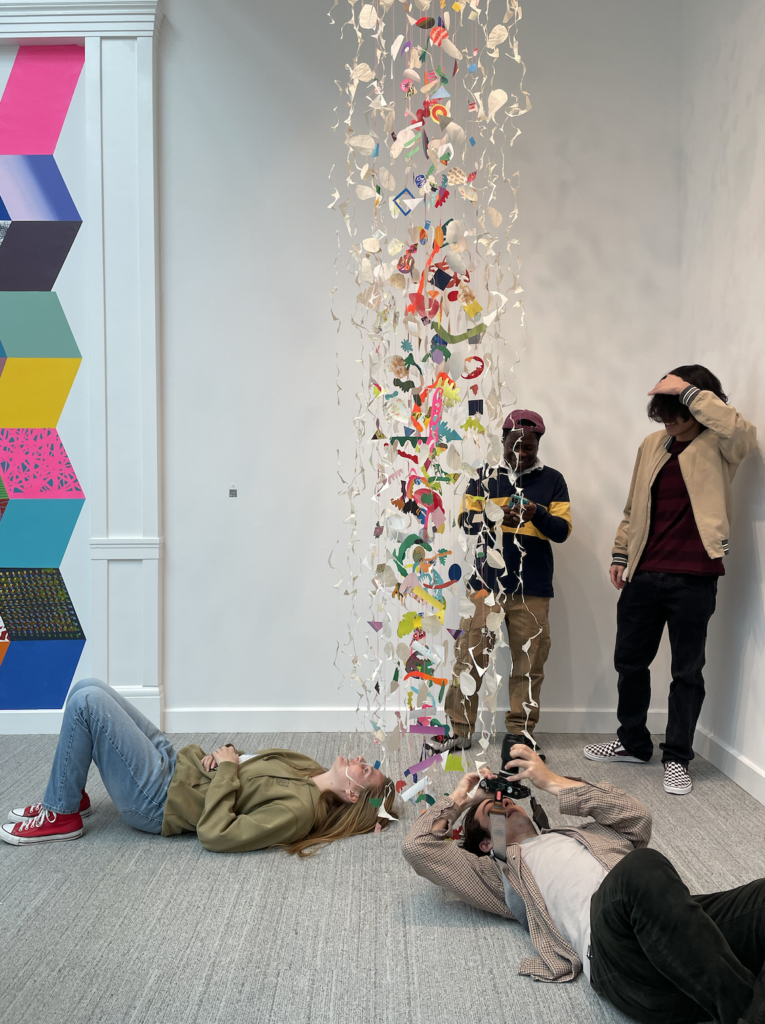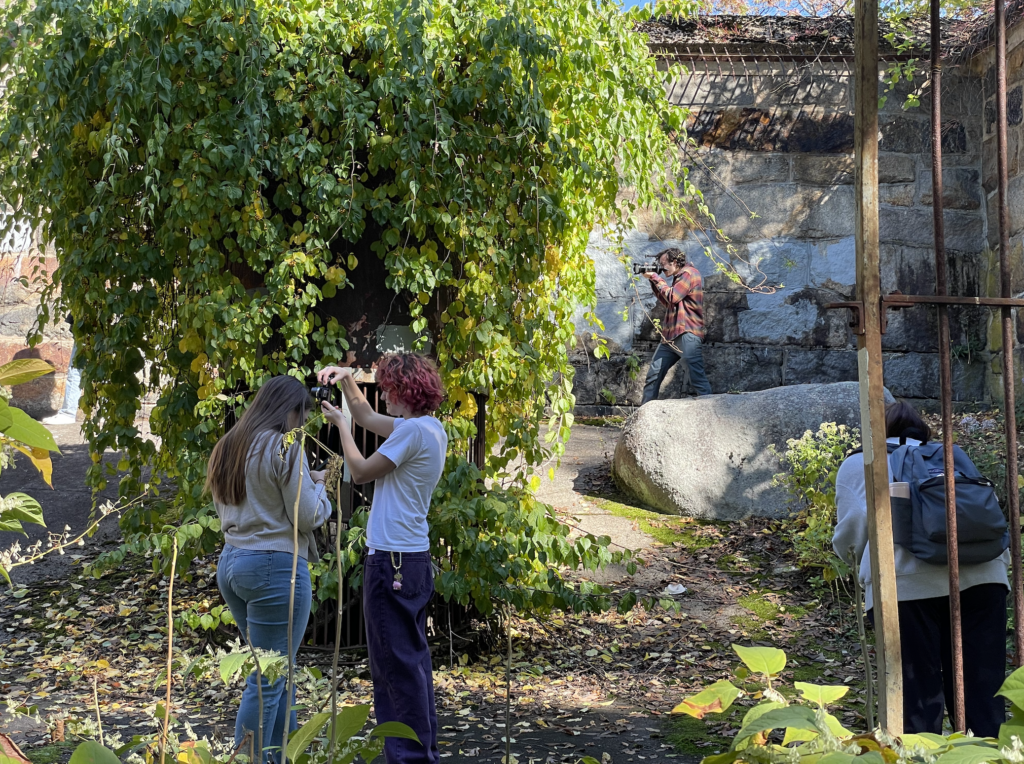‘It’s All True’ Showcase Highlights Outstanding Student Documentaries

With films about climate, culture, age, and memory, the 11th Annual Showcase of Outstanding Student Documentaries will feature a variety of stories from both student and professional filmmakers.
“We started It’s All True to raise the profile of nonfiction filmmaking at Emerson, where fiction and TV narratives predominate,” said co-organizer Visual & Media Arts Professor Marc Fields. “The art of documentary encompasses an expanding range of forms and subjects, so we encourage all types of documentary.”
The showcase is on April 2 and 3, with Sundance filmmaker Kirsten Johnson screening her Emmy Award- and Sundance Film Festival-winning 2020 documentary, Dick Johnson Is Dead, on the first night. In the film, Johnson creates elaborate and comical death scenes of her father to cope with his inevitable passing.
A Q&A with Johnson will follow the screening, which is at 7:00 pm in the Bright Family Screening Room at the Paramount Theater. Admission is free for the Emerson community.
The student documentaries will be screened the second night at 7:00 pm in the Bright Family Screening Room as well. Johnson will provide opening remarks before seven student documentaries are shown.
“The student showcase gives us the opportunity to see how Emerson filmmakers are reinventing the documentary form and exploring new grounds in nonfiction storytelling,” said VMA Associate Professor and BFA Program Director Korbett Matthews, co-organizer .
There will also be a $500 cash award provided by the Virgin Unite Foundation for a social impact documentary.
“At the core, documentary filmmaking is about exploring, asking questions and opening up dialogue,” said VMA Associate Professor Jesse Epstein, who also helped organize the event. “It’s about showing real-life conflicts and hope for resolution. And, it’s also about the deep empathy of really listening to people, learning about their perspectives, and honoring their experiences.”

Epstein said that being able to find the “universal in the small” makes documentaries so compelling.
“There’s honestly so much exciting stuff going on at Emerson with documentary filmmaking,” Epstein said. “Experimental, investigative, personal, and more; I’m seeing more students push the boundaries of the art form in bold and creative ways. I think my role is to listen to what students are innately interested in, and to help draw out their instincts and ideas — so that the inspiration really comes from their own curiosity.”
The featured student films include:
Time to Decide (Te Wā Ki Te Whakatau) by Zander Colman ’25
Time to Decide (Te Wā Ki Te Whakatau) uncovers the relationship between indigenous people in New Zealand and the ocean, as well as New Zealand’s fishing industry. Colman was inspired when he was studying abroad at the University of Auckland last spring.
“A respect and aim at conservation for our natural world has remained a large part of my filmmaking work,” Colman said.
In the documentary, Colman interviewed the representative of the country’s largest Maori-owned fishery, a professor, a climate activist, and a fisherman in Auckland.
“Through Jesse’s [Epstein] guidance and screening a series of rough cuts, the [workshop class led by Epstein] gave helpful notes to push my film further. I was given countless creative ideas and the final version of Time to Decide (Te Wā Ki Te Whakatau) was thanks to such a collaborative class environment.”
Spontaneous Activity of Children by Jiale Li, MFA ’24; Kat Fitzgerald, MFA ’24; and Emma Rose, MFA ’25
For their Advanced Documentary Production class, Li, Fitzgerald, and Rose were assigned to make a short film about “play”. While most people thought of children, they decided to take a twist and use animation to follow the story of Li’s grandmother, as older people are rarely shown “playing”. They also teamed up with Michael Semanic from Berklee College of Music, who composed the music. The film placed third in the Mass Reality Check category at the Salem Film Festival this year.
“We wouldn’t have made this film without our professor, Jesse Epstein, and her encouragement throughout the entire process,” Fitzgerald said.
Chronic Dissonance by Ethan Gabert-Doyon ’22
Gabert-Doyon chose his documentary topic after spending his first few years in college in and out of psychiatric hospitals. He said the most useful techniques he learned at Emerson were creating voiceovers and establishing a relationship between sound and image.
“I had felt the need to hide that part of me, but making this film was very cathartic in that regard,” Gabert-Doyon said.
We Have a Show by Xudong Liu, MFA ’24
Liu’s We Have a Show looks at ways to appreciate cultures authentically in an era when many people appropriate cultures without understanding their roots. Liu said that taking the Hybrid Documentary Production course helped him apply different production strategies to filmmaking.
“From traditional interviews and observational recordings to the incorporation of archival footage, animation, 16mm film, and even reenactments, I learned that creativity in utilizing these methods is paramount to crafting compelling narratives,” Liu said.
Of Myself by Tati Chavitage, MA ’25
In Of Myself, Chavitage explores changing her perception through tangible and intangible forms. Through photos, videos, and illustrations, along with her memory, she seeks to “interrogate the importance of self-memory” in her life.
“I recently digitized the only VHS home movie from my childhood that exists, and have been thinking a lot about the preciousness of that tape and mourning the fact that so many tapes of my life were lost,” Chavitage said.
The film uses frame-by-frame animation techniques that she learned from 2D Character Animation, taught by VMA Associate Professor Anya Belkina, as well as skills she picked up from Experimental Media with VMA Professor and Associate Chair Kathryn Ramey.
Forced Confession by Saba Ghasemi, MFA ’25
Ghasemi came to the U.S. from Iran during Iran’s “Woman, Life, Freedom” movement. Ghasemi’s documentary features events she saw just days before her flight to the U.S.
“I felt I have a responsibility to share my people’s story,” Ghasemi said.
Ghasemi took Documentary Production with Fields, and chose the topic while taking Cinema and Social Change with VMA Professor and Graduate Program Director John Gianvito.
“I decided to play with the new meaning of split-screen and go text-heavy with this piece, especially since all the images are from social media and news agencies,” Ghasemi said. “I wanted my audience to also pay attention to [the] text and not skip the meaning behind the words.”
The Angie Archives by Claire Maske, MFA ’24
The Angie Archives documents Maske’s emotional experience as she tries to locate every existing picture of her mother, who died of cancer almost 10 years ago.
Categories